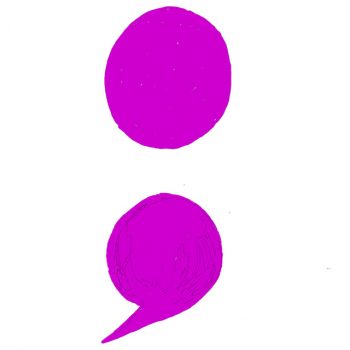Consider the Semicolon Posted by Gary Locke on Jan 4, 2018 in English Language
It sits on our keyboards next to the L, below the colon, and beside the apostrophe and quotation marks. Neither a comma nor a period, the semicolon is a tool for connecting thoughts, erasing confusion, and adding style to any piece of writing.
I’ve never understood the confusion over how to use a semicolon, yet I’ve read that writers hate it and editors regularly see it misused, overused, or not used enough. It is one of the essential punctuation marks of our language, for several good reasons, and understanding how and when to use it will make you a better writer of English.
Let’s begin by defining why the semicolon exists. It separates two or more independent clauses within a sentence, particularly if those clauses aren’t joined by a conjunction. It also separates lists or references which also contain commas. I’ll cover that later. For now, we’ll focus on the semicolon’s place in what has come to be known as syntactic punctuation.
We know that syntax is the art of placing words in their correct order for clarity of understanding. Syntactic punctuation is the art of placing punctuation within sentences and other passages of writing to make them easier to understand. The semicolon, as far as the English language is concerned, clarifies that two seemingly unrelated clauses belong together.
- Amy’s parents sat beside her drinking tea; Amy was drinking Scotch.
- The warmth of the blanket around her was soothing; outside a blizzard raged.
Both sentences above contain contradictory, independent clauses. Yet, by placing them together they form an entirely different thought. This is the purpose of the semicolon. It is mostly a stylistic expression. The clauses could have been separated by full-stop punctuation marks, like a period.
- Amy’s parents sat beside her drinking tea. Amy was drinking Scotch.
Or, perhaps, the writer could opt for using a conjunction.
- Amy’s parents sat beside her drinking tea, but Amy was drinking Scotch.
There’s a different feel to each example. Punctuation can do that. Place something here and your emotions and perception will be entirely unlike the way you would feel if something different was used.
- Amy’s parents sat beside her, drinking tea, but Amy was drinking Scotch!
The semicolon is equally helpful in linking independent clauses in quotations. You may often find this in works of fiction.
- “I found your cat,” she said; “it was sleeping next to the book you also said was gone.”
Some might try to use what is known by editors as a comma splice, putting commas everywhere as a way to connect independent clauses. This results in confusion, as well as really ugly sentences.
- Doctor Osborn knew that his patient was sick, rest and aspirin wouldn’t cure him.
Many authors and editors would argue that the semicolon is largely unnecessary. After all, as you’ve seen, its use is a matter of style and choice. The American author Kurt Vonnegut famously expressed this opinion of the semicolon: “First rule: Do not use semicolons. They are transvestite hermaphrodites representing absolutely nothing. All they do is show you’ve been to college.”
That’s a little harsh. We’ve seen that the semicolon can really project just the right feeling in a sentence when properly handled. More importantly, though, we must remember that there is another important use of the semicolon in English. Without the semicolon, some lists and groupings would make absolutely no sense whatsoever.
- We wish to thank Evelyn Snow, Professor of Literature at Bigly University; Boris Brown, Ph.D. and Professor Emeritus of Drumph College; and Jolene Joesephat, Artist in Residence at Waco State, and Guest Lecturer at Brimstone Prep.
Imagine separating all those people and their titles with only commas. It would be unreadable.
The semicolon has a valuable place in English writing. It can, perhaps, be overused, but it should not be ignored.

Build vocabulary, practice pronunciation, and more with Transparent Language Online. Available anytime, anywhere, on any device.





Comments:
Janet:
I admit, I’m a fan of commas (a fact that will NOT surprise anyone who knows me), but I like semicolons too. How would we make winking sideways smiley faces without them? 😉
More seriously, this is one of clearer explanations I’ve heard about this often-misunderstood punctuation mark. Thanks!
One tiny thing – I suspect you meant that Amy’s parents are sitting “beside her” rather than “between her” – either that, or you meant to say she’s sitting between the two of them. You can’t sit between a single person without things getting a little awkward. 😉
gary:
@Janet Thanks, Janet. And, yes, Amy is sitting between her parents, therefore, they are beside her. I shall now amend the post accordingly.